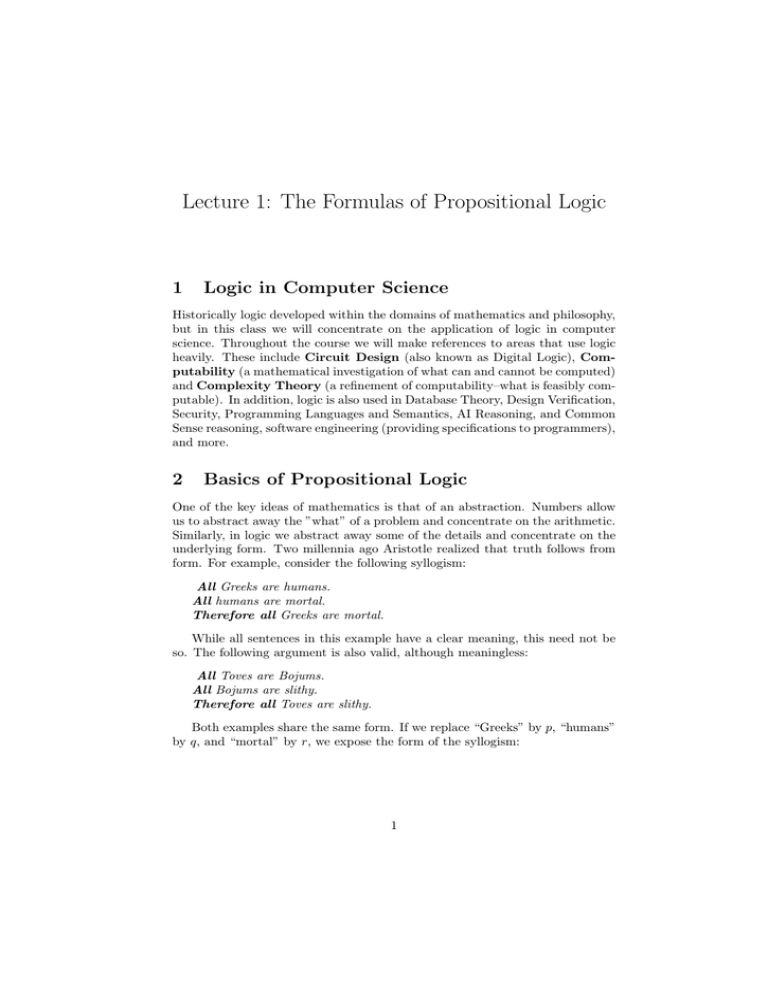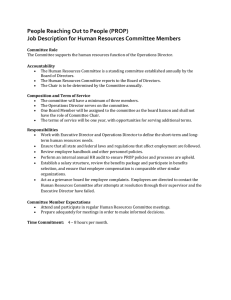Lecture 1: The Formulas of Propositional Logic 1 Logic in Computer Science
advertisement

Lecture 1: The Formulas of Propositional Logic
1
Logic in Computer Science
Historically logic developed within the domains of mathematics and philosophy,
but in this class we will concentrate on the application of logic in computer
science. Throughout the course we will make references to areas that use logic
heavily. These include Circuit Design (also known as Digital Logic), Computability (a mathematical investigation of what can and cannot be computed)
and Complexity Theory (a refinement of computability–what is feasibly computable). In addition, logic is also used in Database Theory, Design Verification,
Security, Programming Languages and Semantics, AI Reasoning, and Common
Sense reasoning, software engineering (providing specifications to programmers),
and more.
2
Basics of Propositional Logic
One of the key ideas of mathematics is that of an abstraction. Numbers allow
us to abstract away the ”what” of a problem and concentrate on the arithmetic.
Similarly, in logic we abstract away some of the details and concentrate on the
underlying form. Two millennia ago Aristotle realized that truth follows from
form. For example, consider the following syllogism:
All Greeks are humans.
All humans are mortal.
Therefore all Greeks are mortal.
While all sentences in this example have a clear meaning, this need not be
so. The following argument is also valid, although meaningless:
All Toves are Bojums.
All Bojums are slithy.
Therefore all Toves are slithy.
Both examples share the same form. If we replace “Greeks” by p, “humans”
by q, and “mortal” by r, we expose the form of the syllogism:
1
If p then q.
If q then r.
Therefore If p then r.
This syllogism has a name: transitivity of implication. An implication is shown
in the statement If p then q, which means p implies q.
p and q above are called symbolic variables. A symbolic variable reflects
some underlying quantity which is, at this point, unknown. The possible values
of these variables are the truth values. Symbolic variables obey the The Law
of the Excluded Middle which says that variables are either true or false,
and there is nothing in between. This is a very sharp world. Consider the sand
heap paradox. Start with a heap of sand. Take the sand away one grain at a
time. Initially, the heap will seem to remain a heap, although we are moving in
induction steps of one grain at a time. This is known as false dichotomy, where
induction seems to be failing, as after enough steps, eventually the heap of sand
will stop being a heap of sand, but we will not be able to tell precisely when.
This world true and false is idealized. We abstract away the gray cases.
This abstraction corresponds to the digital abstraction in electrical engineering. In electrical engineering voltages above some threshold indicate 1, and
below another threshold indicate 0. One might say computer science begins
when you have a circuit you can pretend is digital.
These symbolic variables are propositions. A symbolic proposition is a property that can be either true or false. They are assertions of truth about the
world. In the first part of the course we will regard propositions as indivisible
units without intrinsic structure. This paradigm is called propositional logic,
also known as sentential logic.
In order to create formulas we use propositional connectives. The connectives can be classified according to the number of propositions that they
apply to:
• Unary: not ¬
• Binary: and ∧, or ∨, xor ⊕, implies →, equivalent ↔
• Ternary: if-then-else
As a shorthand, sometimes we will use ◦ to indicate any binary connective.
The set of atomic propositions is called Prop. Prop, the set of connectives
and the left “(” and right parentheses “)” form the alphabet of propositional
logic. Using this alphabet we now can write strings of alphabetic symbols, or
expressions. For example:
(p ∧ q → r)
)q → (r∧
The first expression is ambiguous and this ambiguity can be resolved by
using more parentheses. Intuitively, there is something wrong with the second
expression, but it still fits the definition of an expression. We will use the term
formulas to indicate expressions with the “right” form. This intuitive notion
can be formalized as following:
2
Definition 1 The set of formulas Form is the smallest set with the following
properties:
1. Prop ⊆ Form
2. If ϕ ∈ Form, then (¬ϕ) ∈ Form
If ϕ and ψ ∈ Form, then (ϕ ◦ ψ) ∈ Form.
The second property in the definition is called the closure property. Also
note that in some texts the formulas are called well-formed formulas or wffs.
In order to be sure that Form is well defined, we need to show that there
exists a unique smallest set that has the above properties. This task is the
subject of the next lemma.
Lemma 1 (Smallest set) There is a unique smallest set of expressions that
contains Prop and satisfies closure.
T
Proof: Let Form0 = { P : Prop ⊆ P and P satisfies closure }.
0
Claim: Form is the smallest set with these two properties (closure and containing Prop).
1. Prop ⊆ Form0 : Prop is a subset of Form0 because Form0 is the intersection of sets that contain Prop.
Form0 satisfies closure: Suppose that ϕ and ψ ∈ Form0 . From the way
we constructed Form0 follows that ϕ and ψ are in all expression sets P
that satisfy closure and contain Prop. In particular, closure implies that
(¬ϕ) and (ϕ ◦ ψ) must also be in all these sets P , and consequently, also
in their intersection. This means that (¬ϕ) and (ϕ ◦ ψ) are in Form0 ,
therefore Form0 satisfies closure.
2. Form0 is the smallest set with these properties: To show this, we need to
show that Form0 is a subset of every set that has the two properties. To
that end, suppose that P is a set that contains Prop and satisfies closure.
We know, Form0 = P1 ∩ P2 ∩ P3 ... Now, if X = Y ∩ Z, then it implies
that, X ⊆ Y . From the way we constructed Form0 , the intersection of
two or more sets is always a subset of them all, including the smallest P .
Since, the intersection is Form0 , therefore Form0 ⊆ P .
♦♦♦
Thus we have shown that there is a smallest set (namely Form0 ) that contains Prop and satisfies closure. Therefore Form = Form0 .
The previous definition of Form is non-constructive, which can make proofs
about Form inconvenient. Alternatively, we can define Form inductively.
3
3
Defining Form by induction
Definition 2 Form’:
1. F orm0 = Prop
2. F ormi+1 = F ormi ∪ {(¬ϕ): ϕ ∈ F ormi } ∪ {(ϕ ◦ ψ): ϕ, ψ ∈ F ormi }.
S∞
3. Form’ = i=0 F ormi
Form will refer to the first definition and Form’ will refer to the inductive
definition. This inductive definition ”builds from below.” The question now is
this: Are both of these definitions equivalent? The answer is yes, as is shown
by the next lemma.
Lemma 2 Form = Form’
Proof To prove equivalence is to prove containment in both directions. Therefore we can prove that Form = Form’, if we can show that Form ⊆ Form’ and
Form’ ⊆ Form.
1. F orm ⊆ F orm0 . We will show that F orm0 satisfies the two key properties:
contains Prop, and satisfies closure.
• P rop ⊆ F orm0 , F ormi ⊆ F ormi+1 ⇒ P rop ⊆ F ormi
Therefore P rop ⊆ F orm0 .
• Let ϕ, ψ ∈ F orm0 . From the way we build F orm0 it follows that
there must exist i and j, such that ϕ ∈ F ormi and ψ ∈ F ormj . Let
k = max(i, j). Clearly ϕ, ψ ∈ F ormk .
(¬ϕ) ∈ F ormk+1 ⇒ (¬ϕ) ∈ F orm0 and
(ϕ ◦ ψ) ∈ F ormk+1 ⇒ (ϕ ◦ ψ) ∈ F orm0
We have shown that F orm0 satisfies closure and contains Prop.
Since F orm is a subset of every set with these two properties, it
follows that F orm ⊆ F orm0 .
2. F orm0 ⊆ F orm.
We need to show that if P contains Prop and satisfies closure, then
F orm0 ⊆ P . We do this by using induction on i.
Base: F orm0 = P rop ⊆ P
Induction:
F ormi ⊆ P
F ormi+1 = F ormi ∪ {(¬ϕ) : ϕ ∈ F ormi }
∪ {(ϕ ◦ ψ) : ϕ, ψ ∈ F ormi }
By closure: F ormi+1 ⊆ P
4
In mathematical writing, there is a tricky balance between rigor and readability. You can imagine a proof that is precise to every detail and can be
checked by a machine. But if it looked too arcane to the human eye, it would
be useless in easily conveying the information to the reader. (Think about trying to read assembly versus reading Java or OCAML). Of course, if a proof lacks
the necessary details it can’t be used for anything. This balance if something
you should always be thinking about when you write proofs. The previous proof
is a good example of how to prove simple things rigorously.
Typeset with LATEX 2ε
5



